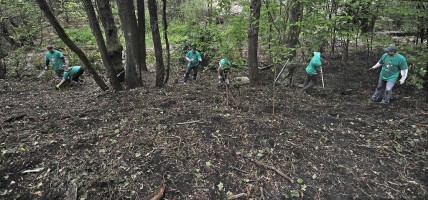Widgetized Section
Go to Admin » Appearance » Widgets » and move Gabfire Widget: Social into that MastheadOverlay zone
Research to Practice: How Cross-Sector Partnerships Lead to Stronger Volunteer Programs
The views expressed are those of the author and do not necessarily reflect the views of ASPA as an organization.
By The Intersector Project
November 22, 2016
With 20,000 employees, an impressive 293 million visitors last year, and national park sites in 27 states, the U.S. National Park Service’s work is expansive both in scope and geography. In order to actualize its mission of preserving “the natural and cultural resources and values of the National Park System (NPS) for the enjoyment, education, and inspiration of this and future generations,” NPS works with thousands of outside organizations. An article recently published in Nonprofit Management and Leadership, “Structures, Challenges, and Successes of Volunteer Programs Co-managed by Nonprofit and Public Organizations,” takes a close look at successful cross-sector partnerships among NPS and nonprofit organizations to co-manage volunteer programs, “a growing, but previously unexamined phenomenon,” at several national park sites including Acadia, Arches and Canyonlands, Cuyahoga Valley, Golden Gate, the National Mall and Yosemite.

The findings of authors Joe Follman, adjunct professor and program administrator at George Washington University, Maria Cseh, associate professor at George Washington University, and Jeffrey Brudney, professor of innovation in the nonprofit sector at the University of North Carolina at Wilmington, suggest that volunteer programs co-managed by organizations from multiple sectors that employ a combination of research-based best practices, including those listed below, result in expanded volunteer programs and stronger partnerships.
Of 14 NPS sites originally assessed for the article, the top six were chosen for further study which consisted of visits to the sites for more in-depth understanding and data-gathering, and participant observation at three sites. Research also consisted of 33 semi-structured interviews with NPS and nonprofit staff involved in the co-managed volunteer programs and analysis of documents related to the programs.
Takeaways will also be of interest to leaders seeking to begin, expand, improve or sustain cross-sector partnerships in volunteer-oriented efforts.
Takeaways for Practitioners
- Craft a shared program mission and goals with leaders from all partnering organization(s) to serve as a beacon for cross-sector staff. In the case of partnerships between the NPS and nonprofits, the partners had similar missions. Despite these similarities, they still faced challenges in working together. Leadership from partnering sectors should meet multiple times to capture in writing the “communal will of both these organizations,” which should then be vetted and approved by key stakeholders from each partnering organization. Follman shared in a phone conversation with The Intersector Project that the mission and goals “served as a beacon” for staff from either sector to follow in designing the programs. Follman also stated the three strongest partnerships in this study spent a great deal of time discussing, drafting and sharing feedback to “develop specific missions and goals governing their volunteer program partnership and that further laid out who was doing what and how it was supposed to work.”
- For an example of a jointly crafted shared mission and goals document for both internal and external audiences, see the Golden Gate Volunteers in Park Program Mission.
- For a guide to jointly identifying desired outcomes related to a challenge, see The Objective Assessment, in the “Partnership Development Toolkit” (found in Section 2.2: Problem and Objective Assessment on pages 17-22).
- Create written agreements, such as memoranda of agreement (MOA), memoranda of understanding (MOU), or other forms of contracts, like cooperative agreements. (For more on the differences between MOAs and MOUs, see here.) Despite having a shared goal, partners may still experience challenges around decision making, control over allocating funds, and responsibilities. Building agreements into the partnership’s structure can help partners navigate these conflicts and facilitate the sharing of funds, staff and equipment (including purchase, maintenance and storage) among partners. These documents may range in specificity from open-ended guiding documents to highly specific guidelines.
- For a succinct explanation of when government agencies should use cooperative agreements, as opposed to procurement contracts or grants, see the Environmental Protection Agency’s website. For an example of a cooperative agreement between the government and nonprofit partners, see Saguaro National Park and the Southern Arizona Buffelgrass Coordination Center’s cooperative agreement.
- Co-locate multisector staff to strengthen communication and relationships among partners. If possible, partners should seek to co-locate staff whose primary work relates to managing the shared initiative. Co-location allows cross-sector partners to receive the same information at the same time, which leads to an increase in joint planning, Follman stated. Co-location also allows partners to communicate daily, strengthening both professional and collegial relationships; eliminates turf issues; and, in the cases of the strongest partnerships studied, breaks down barriers between organizations. For example, an NPS ranger at Golden Gate said the cross-sector partnership they were part of was “just seamless” and that, “When it comes to ‘us’ and ‘them,’ there is no ‘them.’ It’s just an ‘us,’” the article reported.
- For discussion and case examples of how co-location can be a useful mechanism for facilitating collaborative work, see the Victorian Responsible Gambling Foundation’s fourth principle of cross-sector collaboration.
Author: The Intersector Project is a 501(c)(3) nonprofit organization dedicated to advancing cross-sector collaboration as a way to address society’s pressing issues. We work to provide practitioners in every sector with the tools they need to implement collaborative solutions to complex problems.


Follow Us!